For the first time, Ars Electronica was invited to present innovative technologies in the framework of a unique exhibition at the ITU Telecom World 2013 from November 19th to 22nd in Bangkok. From 3D printing to robotics, from creative new energy sources to wearable tech, the exhibition „The Lab“ is about experiencing and questioning future technology and its impact.
Type: Exhibition
Duration: 19-22 November 2013
City, Country: Bangkok, Thailand
Venue: ITU TELECOM WORLD ’13, Bankok, Thailand

The Lab
Proprietary systems are now a thing of the past. The magic word of the future is “open.” In tomorrow’s digital marketplace, there’ll be no place for hermetically sealed-off claims of individual providers. Everything grows together into a big ecosystem in which developers, providers and end users roam and romp worldwide. Here, “plug and serve” solutions are fed in and offered up, demanded and purchased. So these things can be quickly and conveniently loaded to all sorts of mobile devices, and this can be done then and there, whenever and wherever they’re needed. Additional impetus is being imparted to all this by a current development that is nothing less than revolutionary: the so-called internet of things. Nearly all the technical devices and accompanying paraphernalia we use on a daily basis will soon come equipped with sensors, cameras, chips and microprocessors, and be able to be started, operated and updated via the internet.
The quantity of data that will then by constantly careening around the Web will be truly gigantic. The foundation of this digital ecosystem is extremely high-performance, totally pervasive infrastructure that offers everybody optimal network access. Likewise indispensible is achieving the right balance between, on one hand, saving and evaluating user data & behavior, and, on the other hand, protecting people’s right to privacy and data security. This is something that won’t just be in the interest of the end user but also of the economy itself since a lack of trust in the internet will have a growing—and increasingly negative—influence on potential turnover on the online marketplace.
In the context of an open lab situation, Ars Electronica has assembled artistic commentary on this radical transformation process. We present best-practice examples at the nexus of art, technology and society that show the opportunities and risks that the economy, science, politics, art and whole societies could soon be facing. This is a matter of new forms of communication and participation, new types of artists and scientific disciplines, unconventional alliances, and business models with great future promise. We are spotlighting the enormous potential of technological innovations and, thus, the changed relationships of power in political and economic life that will inevitably accompany them.
The Lab is shown at the ITU Telecom World 2013 from November 19th to November 22nd in Bangkok.
Artworks
Ars Electronica Futurelab (AT)
Shadowgram

Shadowgram offers a way to combine the aesthetic experience of creating a physical object—a sticker cut out in the shape of a person’s silhouette—with the idea of taking part in a social brainstorming process. This system enables audience members to discover and apply their creativity.The term Shadowgram refers to an analog photographic technique in which an object sitting on a sheet of light-sensitive paper is exposed to illumination. In the ensuing chemical process, a shadowimage of the object is produced. Shadowgram is a conceptual extension of this idea. Bringing in a video camera, a human-sized light panel, image analysis software and a vinyl cutter creates a system in which the object’s shadow or silhouette is immediately and interactively reproduced in the form of a vinyl sticker.
Golan Levin and Shawn Sims (US)
The Free Universal Construction Kit

The Free Universal Construction Kit is a matrix of adapter bricks that enable complete interoperability between ten popular children’s construction toys. By allowing any piece to join to any other, the kit encourages totally new forms of intercourse between otherwise closed systems. As with other grassroots interoperability remedies, the The Free Universal Construction Kit uses proprietary protocols in order to provide a public service unmet, or unmeetable, by corporate interests. The Free Universal Construction Kit is not a product, but a provocation. It offers working adapters between Lego, Duplo, Fischertechnik, Gears! Gears! Gears!, K’Nex, Krinkles (Bristle Blocks), Lincoln Logs, Tinkertoys, Zome and Zoob—adapters that can be downloaded free from various sharing sites as a set of 3D models suitable for reproduction by personal manufacturing devices such as the Makerbot (an inexpensive, open-source 3D printer). In so doing, The Free Universal Construction Kit prompts consideration about intellectual property, open-source culture and reverse engineering as a mode of cultural practice.
Markus Kayser (DE)
Solar Sinter

In a world increasingly concerned with questions of energy production and raw-material shortages, this project explores the potential of desert manufacturing, where energy and material are abundant.
In this experiment, sunlight and sand are used as raw energy and material to produce glass objects using a 3D printing process that combines natural energy and material with high-tech production technology.
Solar-sintering aims to raise questions about the future of manufacturing and triggers dreams of the full utilization of the production potential of the world’s most efficient energy resource – the sun. While not providing definitive answers, this experiment aims to provide a point of departure for fresh thinking.
Matthew Gardiner (AU/AT)
Oribotics
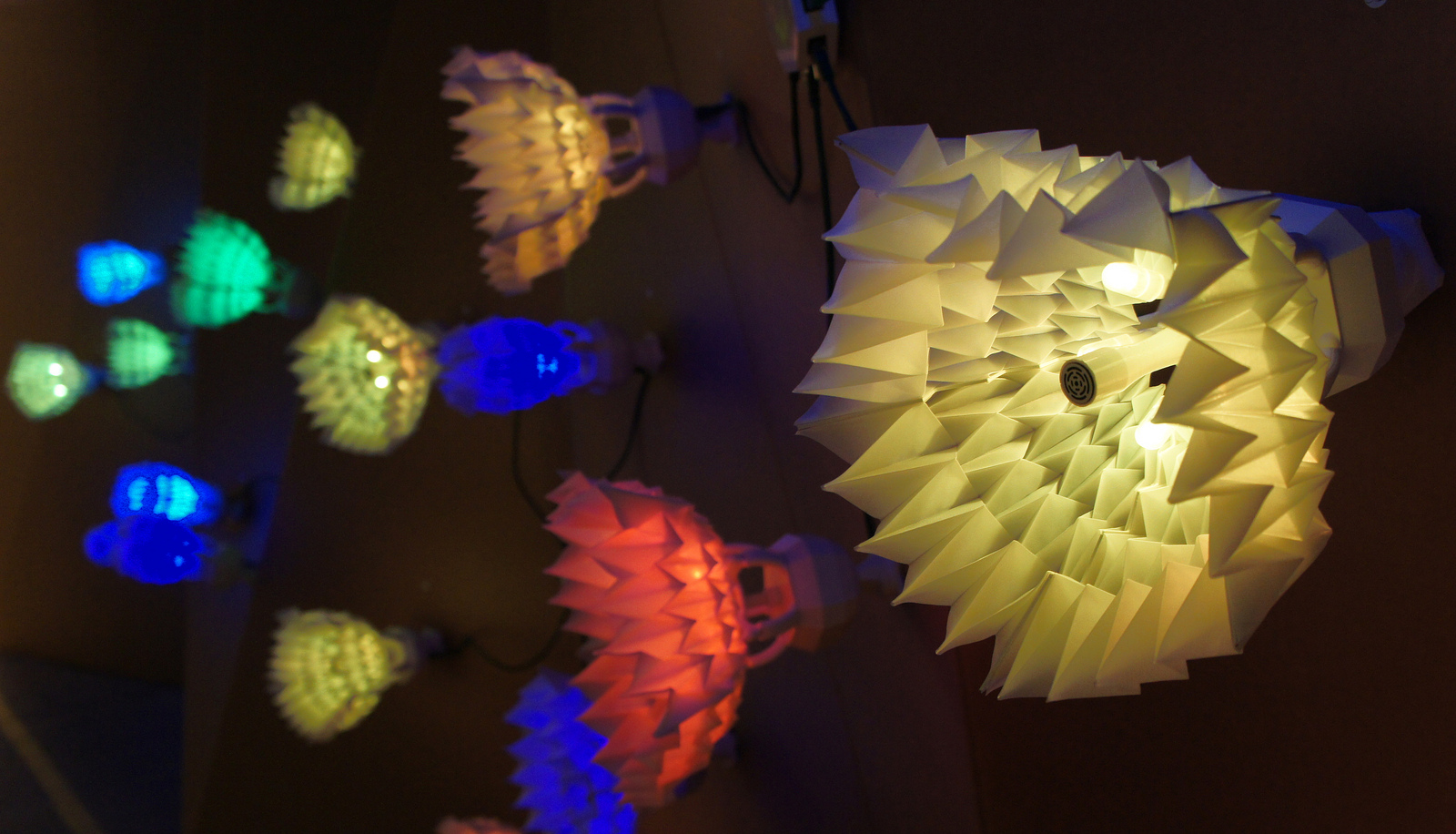
ORIBOTICS are the upshot of an artistically motivated synthesis of the traditional Japanese art of paper folding and state-of-the-art robotics. The artificial plant monitors its surrounding via sensor, opening its blossoms when an object approaches and thereby setting 1,050 folds into motion. When a blossom is activated, the other so-called oribots interlinked with it follow suit in a chain reaction and form an impressive image of a surreal meadow full of flowers. Matthew Gardiner works in what he calls oribotics, investigating aesthetic, biomechanical and morphological connections among nature, origami and robotics. The configuration of patterns of folds—particularly the precise array of V-shaped valleys and Λ-shaped ridges—determines the mechanical design, so that research focuses primarily on the discovery of patterns.
Emiko and Hide Ogawa (JP)
Kazamidori
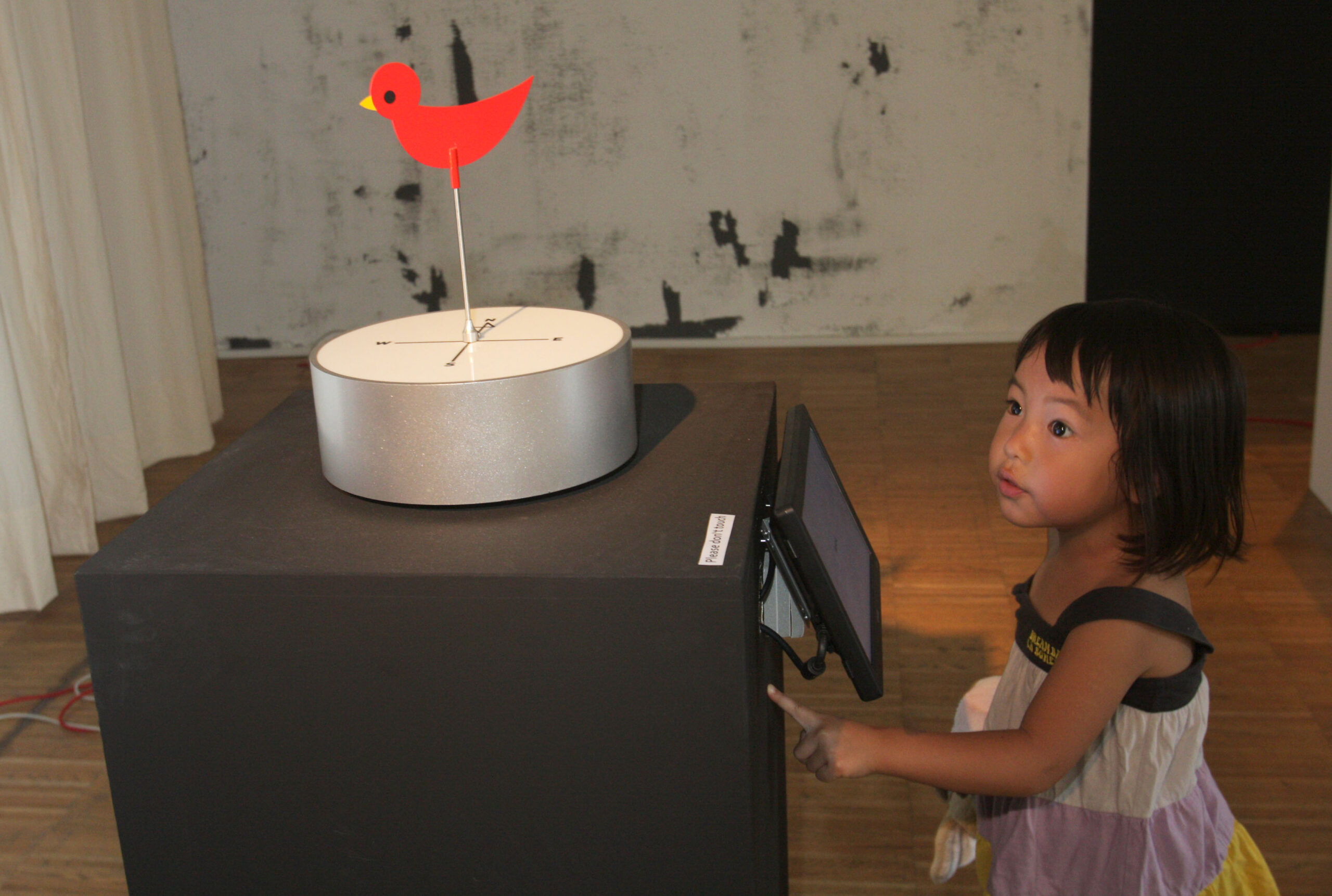
“Kazamidori“ is a weathervane for the Internet age. “Kaza“ (wind) “mi“ (watch) “dori“ (bird) is a Japanese expression for a weathervane. People of former days observed the natural behaviour of birds, which have a habit of looking towards the direction of wind, and this behaviour was incorporated in the design of weathervane. “Kazamidori“ is a device to indicate the social wind of interests on the Internet. It works by using the social energy of web accesses to Ars Electronica. When somebody visits the Ars Electronica website, “Kazamidori“ turns to point in the direction of the visitor. For example, if somebody visits from Tokyo, “Kazamidori“ will point east.)
Brain Computer Interface

Your brain waves are registered by an electrode helmet and analyzed by a computer. Via “Brain Computer Interface” you can operate a computer and write texts by just “thinking of them”.
Paro

Paro is an animal-like robot that has been in use in Japan and Europe since 2003 for therapeutic purposes—for example, providing care to people with Alzheimer’s disease. Modeled on a baby seal, Paro registers environmental stimuli via two computers and five sensors that measure touch, light, sound, temperature and physical position. This enables it to interact with its human interlocutor. Paro is able to learn—it can recognize 50 different voices and responds to its name. The form of a baby seal was selected because most people have no preconceptions about how this creature behaves.
Martin Frey (DE)
Cab Boots
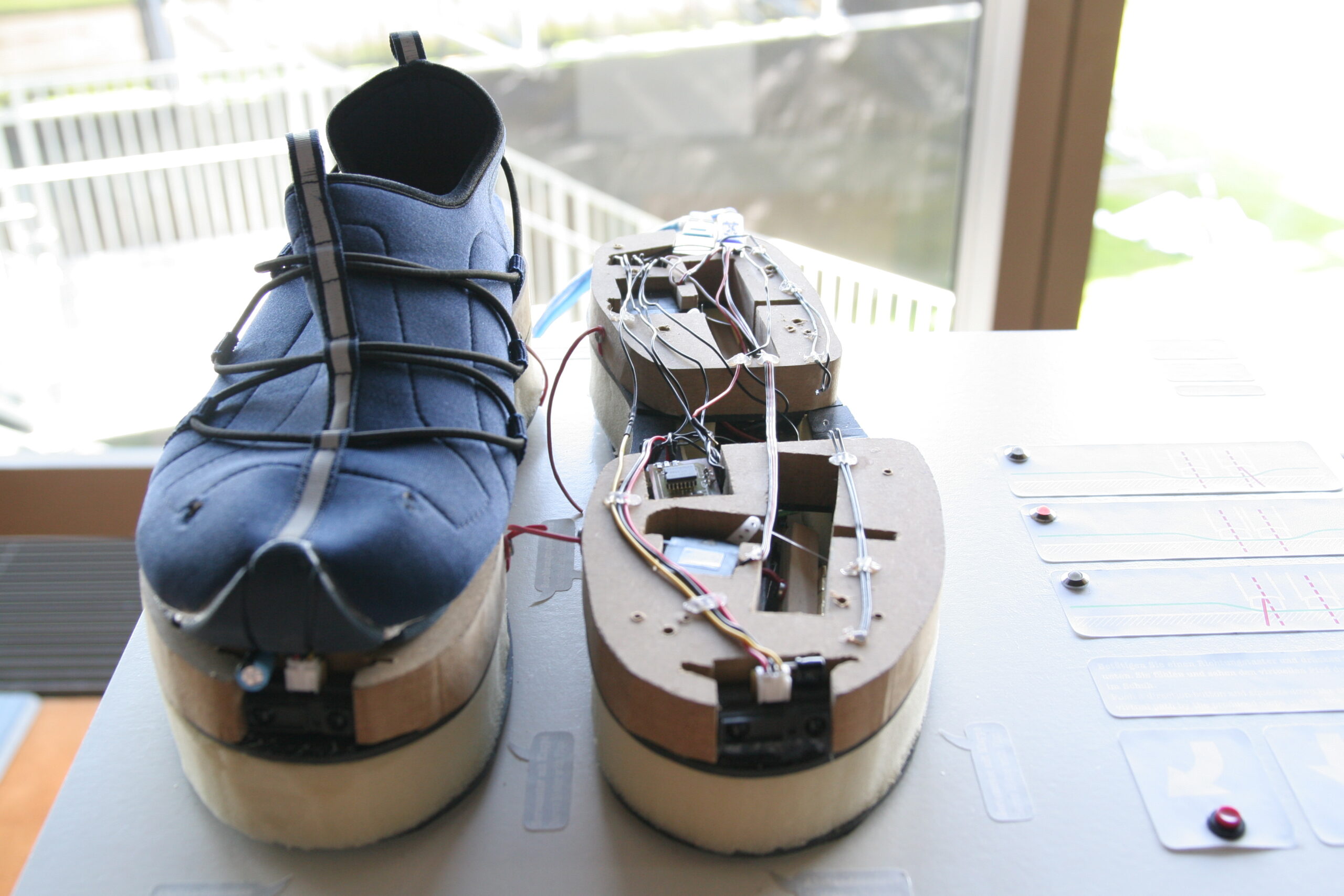
Martin Frey’s “CabBoots” constitute an innovative pedestrian guidance system. The concept stems from the typical topography of a well-trampled hiking trail. Walking along, your feet come down upon flat ground only in the middle of the path. The upward curvature of the ground on the trail’s outer edges produces a slight pronation of the foot. This is where Martin Frey’s “CabBoots” come in. They tilt the soles to the outside or inside and thus steer the wearer in a particular direction. In this way, virtual routes can be navigated without a map – or one’s eyes, for that matter.
Dash Macdonal (UK)
In Your Hands
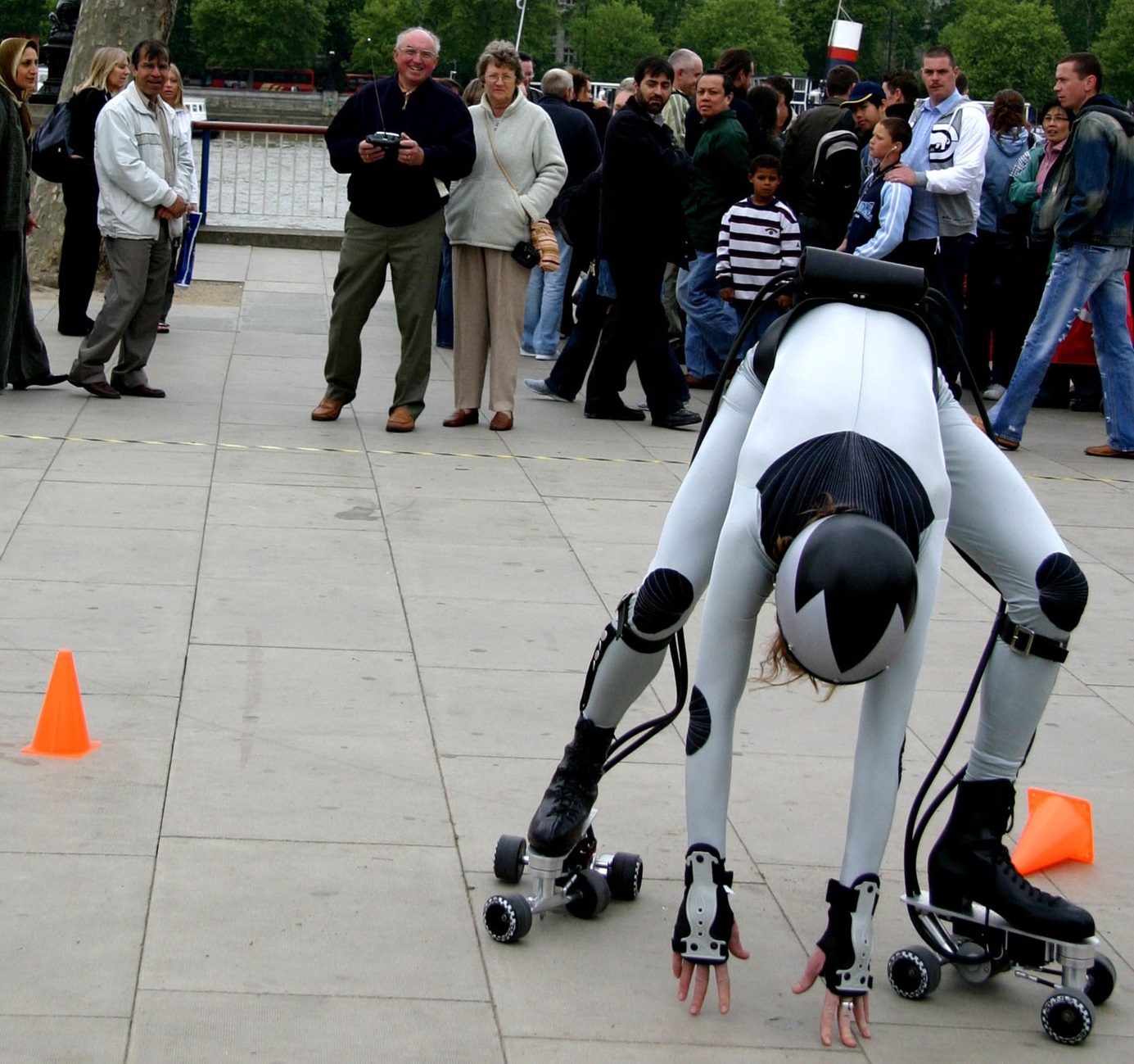
The roller skates Dash MacDonald dashes about on aren’t the kind you buy in stores. His skates can be remote controlled via radio and steered in any direction. In one of his “In your hands” performances, he literally turns over the controls to passers-by, who can then move him about like an action figure. With people faced by such temptation, it doesn’t take long before the skates are being maneuvered into ever-more-absurd and impossible situations – to the great amusement of everyone involved!
Iori Tomita (JP)
TRANSPARENT SPECIMEN (2012)

Japanese artist Iori Tomita turns sea creatures into “fantastic-strange” specimens. As a student, he learned the technique of producing specimens for scientific analysis purposes. The creatures’ muscle tissue is made translucent by dissolving their natural proteins. It takes laboratory techniques developed by scientists to reveal the precise forms created by nature. The body parts are stained, whereby the harder and softer tissues are treated with different colors. Depending on the size of the creature, it can take up to six months to create a specimen. Employing what is actually a method of scientific analysis, Iori Tomita creates bizarre sculptures that can be attributed to both art and science. www.shinsekai-th.com
HGN Hans Georg Näder
Otto Bock

Nature Knows How! Ottobock’s research & development mission is to come as close as possible to the consummate ideal: nature itself. Simply formulated questions yield technological challenges: How does a knee joint function? What stresses does a foot have to withstand on a daily basis? Which terms best describe the operation of the hand as a high-precision organ for grasping? The analysis of natural interrelationships inspires our R&D engineers to think innovatively and come up with novel solutions. In this endeavor, enhancing existing products is just as important as developing new technologies. The results have been a whole series of high-tech breakthroughs.
Intelligent Prostheses and Orthotics Orthobionic® is the term coined at Ottobock to refer to the observation and analysis of bodily functions as a basis for the technical development of prosthetic and orthotic products. From knowledge about natural structures and processes, our engineers derive technical solutions designed with people in mind. The essence of Orthobionic® innovation is interdisciplinary collaboration among experts in technology and medicine. Technicians perform research on the human body to consider how medical findings and insights can be implemented in the form of machines. Orthobionic® is the scientific basis of Ottobock’s technological edge. Modern Wheelchairs and Aids for Mastering Everyday Life Building a better wheelchair means amalgamating knowledge gained from both technical and ergonomic investigations. The results are systems made up of a person and a high-tech aid designed to improve his/her mobility and comfort. Bionicmobility® is the name of Ottobock’s division that includes electrically & manually powered wheelchairs, products for children’s rehabilitation, and the field of neurostimulation.
Neurowear
Necomimi
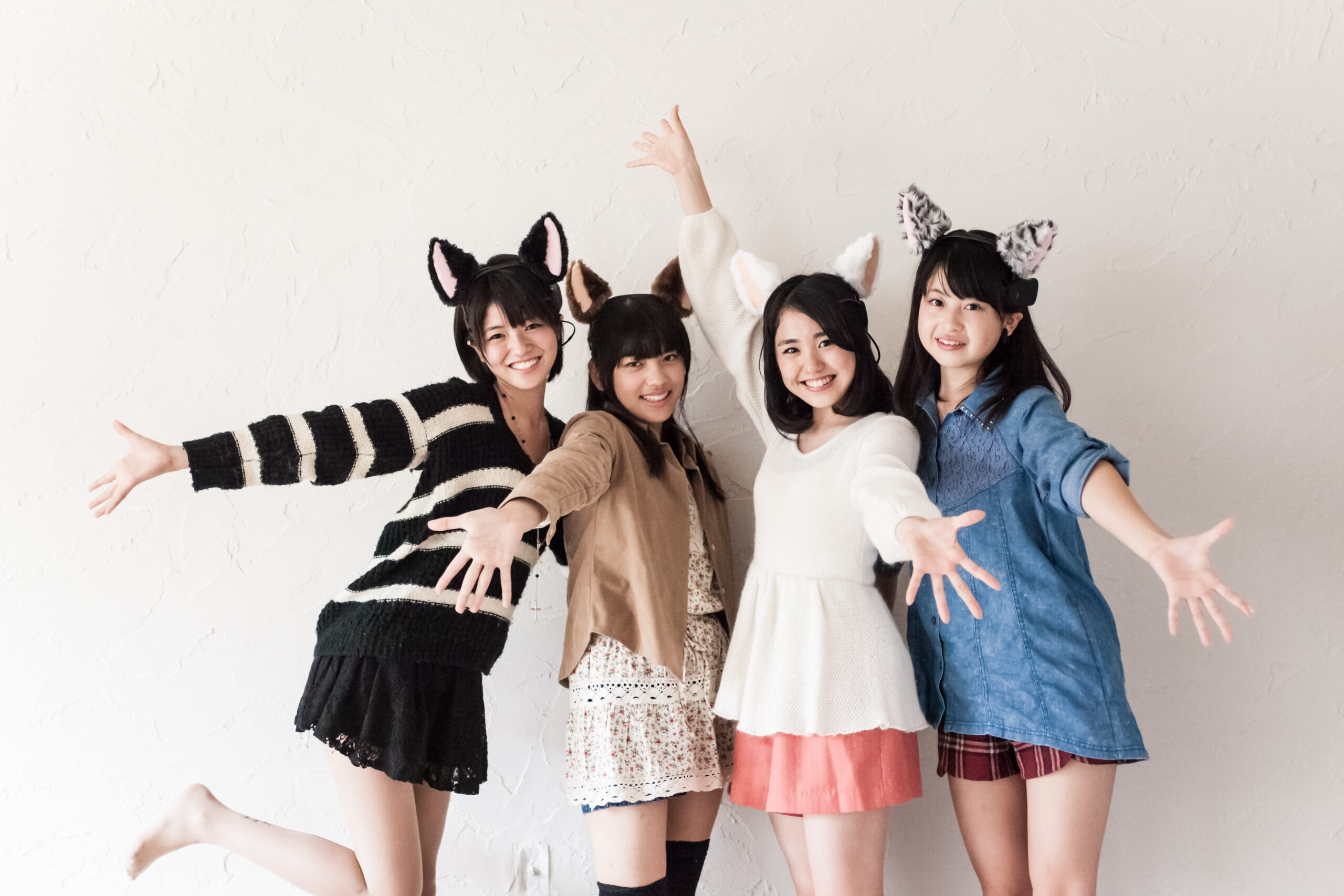
“Necomimi” is world’s first commercialized communication tool using brain wave. When the user is “focused”, the ears will stand up, and when the user is “relaxed”, the ears lie down. If the user is simultaneously “focused” and “relaxed”, as seen with many professional athletes, the ears move rapidly. Using Necomimi, the communication overcoming languages, ages, genders, or races, turns into reality. “Neurowear” is a team of creators based in Tokyo, focused on creating “communication for the near future”. We design prototypes of new products and services based on biological signals such as brain waves, heartbeat etc. www.neurowear.com
Jim Reeves and Martin Riddiford (UK)
Gravity Light
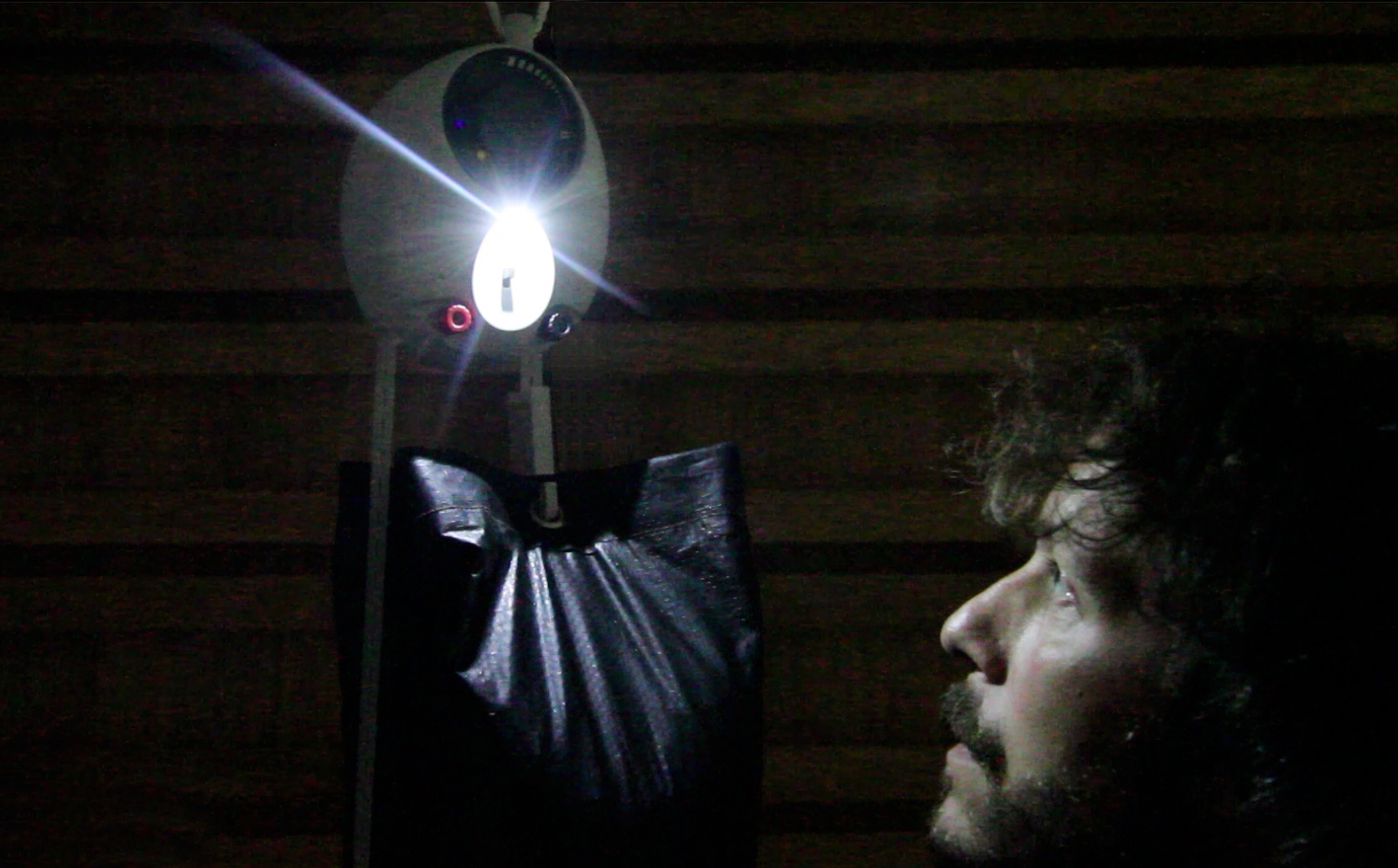
Approximately 1/3 of the World’s population is off-grid (having no access to mains power). This situation is not set to change in the near future, according to the World Bank and the World Health Organisation, and is identified as a major obstacle to the proliferation of education, and recognised as a limiting factor for growth in developing economies. The vast proportion of existing solutions for heat and light in remote, off-grid, areas rely on bio-mass (carbon-based fuel sources). Concerns over ecological impact aside, a reliance on burning biomass for lighting (specifically oil) is expensive, keeping millions in fuel poverty, is unhealthy (producing toxic fumes and poor quality light) and dangerous (fire). GravityLight is a revolutionary and sustainable approach to generating power and light. GravityLight can eliminate the need for kerosene lamps, offering huge health, economic and environmental benefits. It takes around 3 seconds to lift the weight that charges GravityLight, which will provide up to 30 minutes of constant light, as the weight drops under the force of gravity. The weight is a bag (which doubles as the product packaging) that the user fills with 9 – 12.5kg of material (earth, rocks or sand). This connects to GravityLight via a plastic strap, which passes through the generating mechanism. A series of gears and a generator inside translates this slow falling mass into electrical energy. The system can be varied, to provide either task or ambient lighting, or both simultaneously at a lower level. It has terminals on the front to allow it to be used purely as a generator to top up batteries, or to power various low voltage devices, such as FM radios. GravityLight has no batteries to run out, replace or dispose of, and has no reliance on the external environment, time of day, season or weather. As there are no running costs after the initial low-cost purchase, GravityLight has the potential to help lift people out of poverty, who otherwise spend large proportions of their income on kerosene for lighting.
Ars Electronica FutureLab
Brain Battle
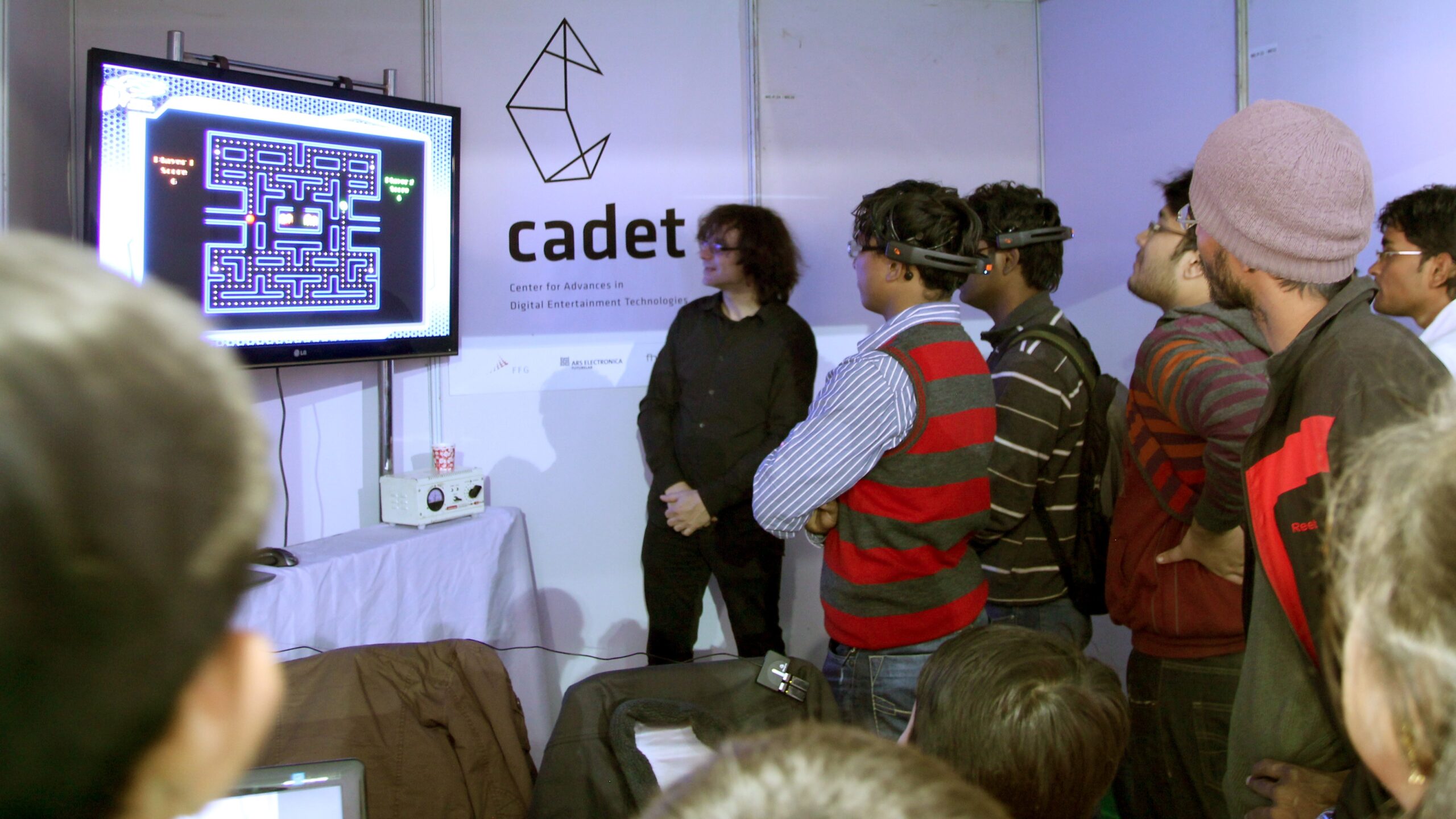
Brain Battle is an extraordinary form of interaction that makes a futuristic game controller available right now: the brain-computer interface. Players use the power of their thoughts to face off in the ultimate form of mental combat. An electroencephalogram (EEG) is something most of us associate with imaging in the medical field, but now this technology has been introduced into computer gaming. In Brain Battle, the aim is not only to control the course of the game via thoughts; the interface also enables players to use body language—for instance, tilting their head or facial expressions—as a form of interaction. This adds a fresh twist to classic computer games like Pong, Space Invaders and Pac-Man.
Louis-Philippe Demers (CA/SG)
The Blind Robot

Louis-Philippe Demers set out to transform a robot arm from a cold precision tool into a sensitive instrument, and thereby create a new form of intimate touch by social robots. In his installation, the mechatronic arm gently feels the faces and upper bodies of installation visitors just like a blind person would do.
Ars Electronica Futurelab (AT)
Spaxels – Ars Electronica Quadcopter Swarm (2012)
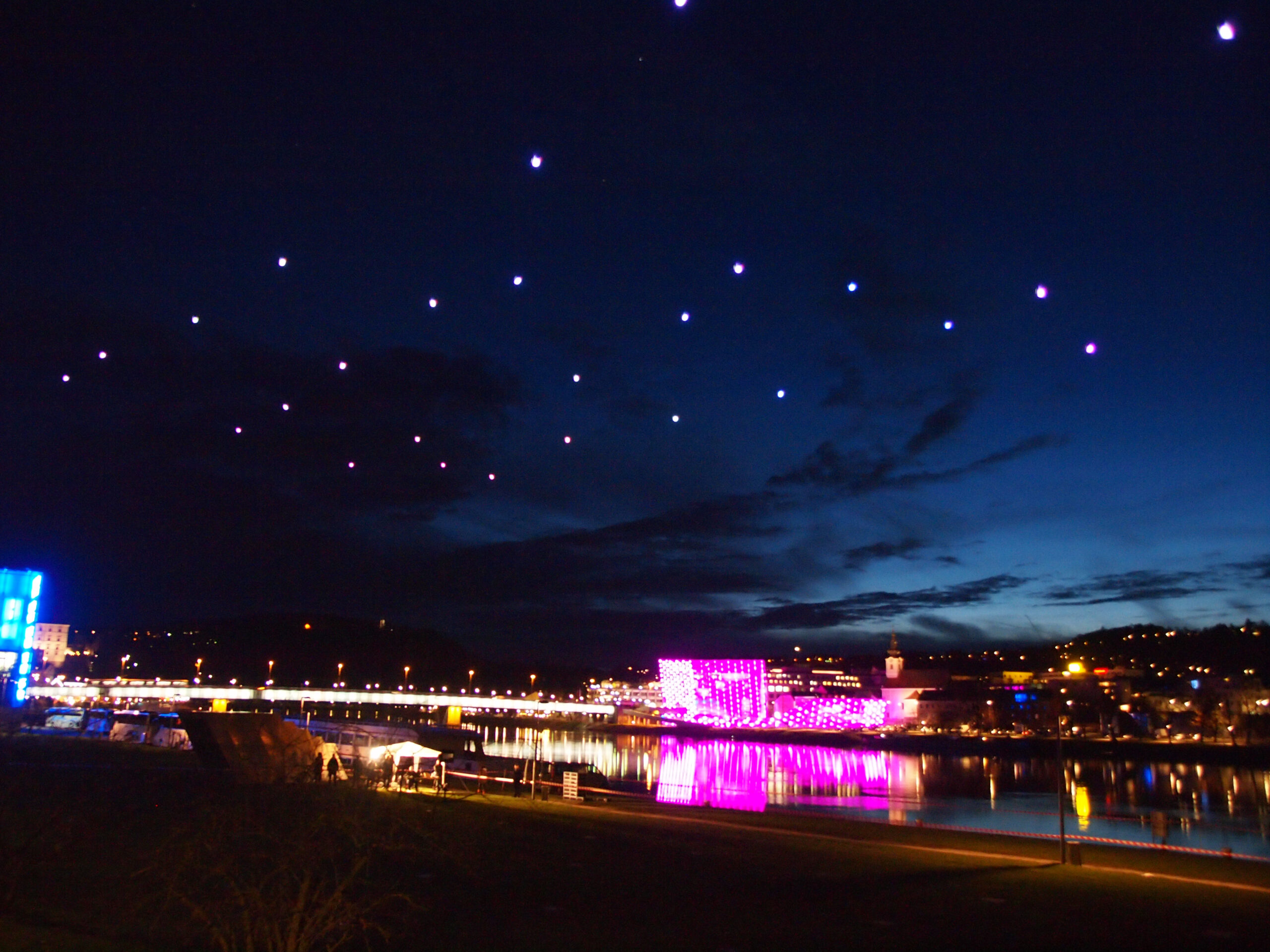
The Ars Electronica Quadcopter Swarm is the hottest international sensation in professional event & show business. It’s a swarm of up to 50 LED-equipped quadcopters that fly in formation and perform cool feats of airborne choreography. The accompanying lighting and sound effects create an extraordinary aesthetic experience. The technology employed isn’t all that’s state-of-the-art; what wows viewers most of all is the performance’s futuristic artistry, which thus lives up to the claim to excellence that has made a name for Ars Electronica worldwide. The Ars Electronica Quadcopter Swarm was one of the featured attractions at the 2012 voestalpine Klangwolke. An audience of 90,000+ gathered along the Danube in Linz to witness a world record: the first outdoor flight by a formation of 50 quadcopters. In March, 2013, the The Ars Electronica Quadcopter Swarm stunned the London public, when 30 quadcopters animated the legendary Starfleet logo in the sky at the occasion of the movie premiere of Star Trek: Into Darkness. In May, 2013, the “Spaxels” were part of the spectacular opening show of the Bergen International Festival in Norway, which was realized in cooperation of phase7 and the Ars Electronica Futurelab. In June 2013, the “Spaxels” visualized the opening concert of the Ljubljana Festival, opening the show with a spectacular flight out of Ljubljana Castle. At the opening ceremony of the new campus at Queensland University in Brisbane, Australia, the Spaxels performed in the southern hemisphere for the first time, in August 2013. In September, the Spaxels’ new, more intense LED system was presented to the public for the first time at the opening of the Ars Electronica Festival 2013 (“We are here”).
Robo Zoo

Sometime in the distant future, a group of scientists is studying that epoch in human history when robots became our constant companions. This is an excerpt from their report on robotic design. When human beings began to coexist with robots, they paid particular attention to their mechanical companions’ appearance, behavior and material composition. The first major source of inspiration for this was nature itself. Human beings observed nature’s own physical forms and modes of locomotion, and sought to apply them to the design of their machines. At first, this resulted in robots assuming a wide range of configurations—replicas of slime molds, plants, dainty fish, insects, butterflies and multi-legged creatures all the way to automatons created in man’s own likeness: bipedal humanoid robots. Humankind’s simultaneous strivings in such fields as the life sciences to decode and modify nature also led to giving free rein to the imagination with respect to how robots might look someday. Occasionally, human beings even dreamt of a time far off in the future when perhaps robots too would have leisure time. What would they do? Clean their apartment? Go work out at the gym? Or maybe surf the internet?
Gustavo Valera (ES)
3D Printer
It seems almost like a paradox: 10 years ago we stored things in our closet, we imagined ourselves being completely virtual or ethereal beings today. Perhaps, disembodied living brain realities. But today, those who were hackers before, became makers and left their computers to use digital printers, laser cutters, and CNC machines to make objects . What happened? Maybe we have to go through the digital to return to the physical, to remember what’s real, to remember what’s good? Will that finally be the revolution? Or maybe realities are more nuanced and in some sectors we are reaching a certain level of maturity where the shape of new objects, begins to take place. At Ultra-Lab we have been asking ourselves these questions for three years. We work with technologies for creation, that allow the members of our community to have access to this tools. Not only 3D printing, but other open hardware devices as well as open software. We aim to contribute to society with a new way of creating things and distributing them, and at the same time this produces knowledge which is shared back into this community.
